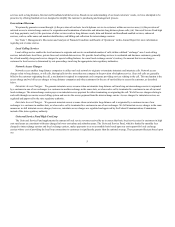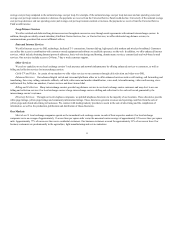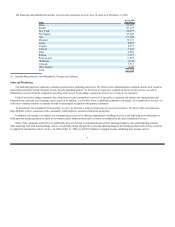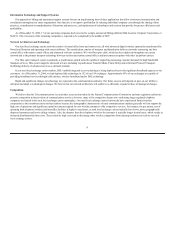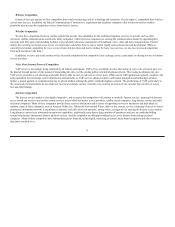FairPoint Communications 2006 Annual Report Download - page 17
Download and view the complete annual report
Please find page 17 of the 2006 FairPoint Communications annual report below. You can navigate through the pages in the report by either clicking on the pages listed below, or by using the keyword search tool below to find specific information within the annual report.
operations, except in Florida where the legislature has determined that all incumbent local exchange carriers are required to provide the additional
interconnection services as prescribed in the Telecommunications Act. If a request for any of these additional interconnection services is filed by a potential
competitor with respect to one of our other operating territories, we are likely to ask the relevant state regulatory commission to retain the exemption. If a state
regulatory commission rescinds such exemption in whole or in part and if the state regulatory commission does not allow us adequate compensation for the
costs of providing the interconnection, our costs would significantly increase, we would face new competitors in that state and we could suffer a significant
loss of customers and resulting declines in our revenues. In addition, we could incur additional administrative and regulatory expenses as a result of the
interconnection requirements.
Promotion of Universal Service
The payments received by our rural local exchange carriers from the Universal Service Fund are intended to support the high cost of our operations in
rural markets. Payments from the high cost loop component of the Universal Service Fund represented 7% of our revenues for the year ended December 31,
2006. Under current Federal Communications Commission regulations, the total Universal Service Fund available to all rural local telephone companies is
subject to a cap. In any given year, the cap may or may not be reached. In any year where the cap is reached, the per access line rate at which we can recover
Universal Service Fund payments may decrease. In addition, the consideration of changes in the federal rules governing both the collection and distribution of
Universal Service Fund is pending before the Federal Communications Commission. If our rural local exchange carriers were unable to receive Universal
Service Fund payments, or if such payments were reduced, many of our rural local exchange carriers would be unable to operate as profitably as they have
historically in the absence of our implementation of increases in charges for other services. Moreover, if we raise prices for services to offset loss of Universal
Service Fund payments, the increased pricing of our services may disadvantage us competitively in the marketplace, resulting in additional potential revenue
loss. Payments from the Universal Service Fund fluctuate based upon our average cost per loop compared with the national average cost per loop. For example,
if the national average cost per loop increases and our operating costs (and average cost per loop) remain constant or decrease, the payments we receive from the
Universal Service Fund would decline. Conversely, if the national average cost per loop decreases and our operating costs (and average cost per loop) remain
constant or increase, the payments we receive from the Universal Service Fund would increase. Over the past year, the national average cost per loop in relation
to our average cost per loop has increased and we believe the national average cost per loop will likely continue to increase in relation to our average cost per
loop. As a result, the payments we receive from the Universal Service Fund will likely decline.
Universal service rules have been adopted by both the Federal Communications Commission and some state regulatory commissions. Universal Service
Fund funds may be distributed only to carriers that are designated as eligible telecommunications carriers by a state regulatory commission. All of our rural
local exchange carriers have been designated as eligible telecommunications carriers pursuant to the Telecommunications Act. However, under the
Telecommunications Act, competitors could obtain the same support payments as we do if a state regulatory commission determined that granting such
support payments to competitors would be in the public interest.
Two notable regulatory changes enacted by the Federal Communications Commission in the last six years are the adoption, with certain modifications, of
the Rural Task Force proposed framework for rural high-cost universal service support and the implementation of the Multi Association Group plan. The
Federal Communications Commission’s Rural Task Force order modified the existing universal service support mechanism for rural local exchange carriers
and adopted an interim embedded, or historical, cost mechanism for a five-year period that provides predictable levels of support to rural carriers. The Federal
15


